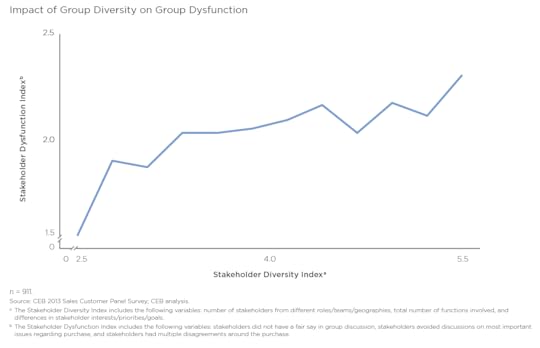Not Closing Deals? Your Customers May Be to Blame
(This is the third in a series of blog posts on our latest research: Creating Customer Consensus .)
As we discussed in an earlier post in this series, the increasing size and complexity of the offerings B2B companies sell has increased the diversity of customer buying groups. This increasing diversity is probably not shocking to you, though—and for good reason. This diversity is visible to anyone looking at today’s customer stakeholder groups. It’s hard to ignore the new people at the table that have little in common with those who have always been there.
What’s less visible—and probably more surprising to you—is the new dynamic that this greater stakeholder diversity has created: dysfunctional stakeholder groups. The data is clear.
As stakeholder groups become more diverse, they are more likely to display the following symptoms of dysfunction:
Stakeholders don’t have an equal voice in group discussions. In diverse buying groups, stakeholders have less experience working together. This inexperience makes it likely that the loudest voice will dominate group discussions, marginalizing other stakeholders who are apt to either veto the deal or squabble about how much money they are putting towards the purchase.
Important issues are ignored. Without a shared understanding of how the purchase could benefit each member of the group, diverse stakeholder groups are likely to get sidetracked with arguments about minor issues. Besides elongating sales cycle times, this can lead the buying group to change their purchase criteria in the late stages of the purchase process—or to abandon the purchase altogether.
Unresolved disagreements. Unable to explain their opinions in ways that others will understand, members of diverse buying groups are likely to abandon productive debates, simply agreeing to disagree with each other. Of course, when everybody agrees to disagree with each other about a purchase, that purchase will never happen.
Besides making it harder to close deals, customer dysfunction has an additional insidious effect. Diverse stakeholders have vastly different mental models—the way an individual sees, thinks about, and talks about the world. This makes it difficult for stakeholders to explain the benefits they’d get from particular features and functionality to the rest of the buying group.
Given that, group discussions tend to drift away from features and functionality to the one thing everyone is able to discuss: price. This means that even when—against all odds—you manage to close a deal with a dysfunctional buying group, you will have faced so much price pressure that the deal won’t close at a high margin. In fact, higher-cost, premium suppliers are 50% less likely to close deals with dysfunctional buying groups.
The data is clear on one additional point: Diversity is not destiny. Although diverse buying groups are more likely to become dysfunctional, sellers can intervene to prevent dysfunction from arising. This antidote to stakeholder group dysfunction will be the subject of our next post in this series.
CEB Sales members, listen to the webinar replay and review the key findings from the study. Also, register for one of our upcoming meetings on the topic.
Brent Adamson's Blog
- Brent Adamson's profile
- 9 followers




